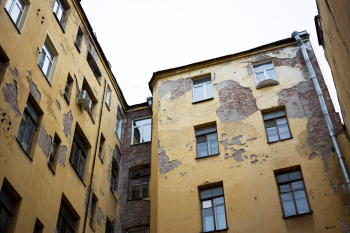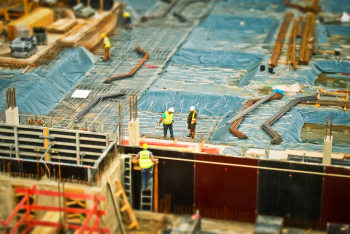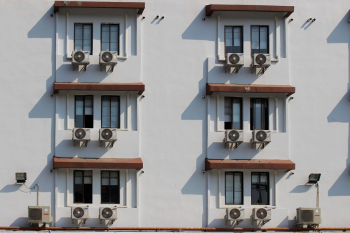

By Michael Anderson | Thu, March 21, 24
Monumental. Seismic. A once- in-a-lifetime opportunity.
The list of metaphors to describe the anticipated outcomes of recent federal investments in the multifamily housing sector has grown ever longer over the past two years. Provisions within the Bipartisan Infrastructure Law (BIL) and Inflation Reduction Act (IRA) aimed at modernizing apartment dwellings in the United States constitute an unprecedented public investment in the nation’s aging affordable multifamily housing stock. While long overdue, this investment could not have come at a more pressing time.
Low- and moderate-income properties in New England and the Mid-Atlantic are widely energy inefficient, as indicated by the significantly higher energy burdens experienced by those who live there. The sheer volume of multifamily housing units in the Northeast makes the sector a critical component of regional state government strategies for greenhouse gas emission reductions. To this end, a growing number of jurisdictions will soon begin requiring owners of multifamily properties to comply with legally mandated building performance standards. Many multifamily properties are old and poorly maintained. Environmental health issues such as asbestos, lead, mold, and other hazards can act as barriers to retrofit projects due to the high cost of remediation. Covering the costs of retrofit projects will be beyond the means of many affordable multifamily property owners.
To maximize the potential of this historic public investment, multifamily stakeholders will need to collaborate both regionally and across public, private, and nonprofit organizations. Because BIL- and IRA-funded projects hold significant potential for supporting rapid and equitable decarbonization in affordable multifamily buildings in the Northeast and Mid-Atlantic, NEEP is increasingly focused on this important issue.
Multifamily Housing as a Pathway to Equity in Regional Carbon Reduction Goals
The relationship between multifamily housing, greenhouse gas pollution, and equity in New England and the Mid-Atlantic is rooted in several factors. Nationally, multifamily housing accounts for one-third of residential dwelling units. Buildings and homes account for approximately three-quarters of the electricity used in the United States, with 20 percent of this total attributed to residential homes. Many multifamily properties are old and inefficient. Around 60 percent of residential apartment buildings were built before 1980, and more than half of these apartments are at least 50 years old.
Older facilities are often neglected, with endemic health and safety issues stemming from inadequate maintenance and insufficient capital investment. Unsurprisingly, these issues disproportionately impact low- to moderate-income communities, who account for 85 percent of those currently living in apartment homes. Many multifamily properties in the Northeast have degraded to such a degree that these buildings pose serious health risks to the residents who live in them.
BIL and IRA requirements that direct funds toward efficiency upgrades at these under-resourced properties will support regional reductions in greenhouse gas emissions while promoting multiple benefits including improved affordability, health, and safety. These funds represent the most significant public investment ever undertaken to improve livability in traditionally underserved multifamily affordable communities.
Anticipation and Uncertainty as Grants Begin to be Disbursed
Despite the promise of BIL and IRA funding, many challenges remain. Will funding complexity act as a barrier to the massive volume of multifamily retrofit projects that federal dollars will subsidize? Do the BIL and IRA fully fund the needs of the sector? How will we make the significant gains in a trained and capable workforce that will be needed to drive deep energy retrofits at multifamily communities? Will BIL- and IRA-funded projects deliver meaningful and sustainable benefits to traditionally underserved communities?
The answer to these questions will not come from one source. Instead, it will require an unprecedented collaborative effort bridging the public, private, and nonprofit sectors. NEEP is involved with several projects that seek to make these connections and create replicable solutions to these questions, including supporting regional teams participating in the Department of Energy’s Buildings Upgrade Prize and collaborating on a networked geothermal heating and cooling pilot project at an affordable housing community in Wallingford, Connecticut.
Affordable Housing Upgrades Will Require Creative Approaches to Funding
Although the IRA and BIL contain significant allocations for the multifamily sector, particularly for subsidized affordable housing communities, these grants are still insufficient to fully meet the sector’s needs.
Factors such as the grant application process, funding schedules, and compliance requirements will complicate fund access for multifamily owners and developers. These stakeholders will need to navigate federal grants as well as state, municipal, and utility funding programs to stay in front of ambitious building performance standards. Many deep energy retrofits will not be sufficiently funded by grants alone and will need the support of lending institutions like green banks and community development financial institutions. The EPA’s Greenhouse Gas Reduction Fund (GGRF) under the IRA is poised to support these institutions for such projects. Subsidized affordable housing projects may need to include tax credit programs and other Housing and Urban Development funding mechanisms. The administrative burden of projects funded through multiple sources will likely overwhelm many affordable multifamily ownership entities. Strategies such as braiding and stacking funding streams and offering one-stop shop program models will help fully leverage the coming influx of money in a way that pays both direct and indirect project costs. Property owners will need support from the public, private, and nonprofit sectors to fund decarbonization projects comprehensively.
Special Considerations for Multifamily Affordable Retrofit Workforce Development
Another anticipated gap in assuring a net zero future for residential homes in New England and the Mid-Atlantic is the current shortage of a skilled workforce large enough to take on decarbonization projects at scale. This problem is particularly acute in the multifamily sector, where building retrofit contractors and trade workers must possess significantly different skill sets and capacities than those who work in single-family homes.
At the same time, residents in low and moderate-income communities in the country face higher rates of unemployment than the national average. While BIL and IRA contain grants for workforce development efforts, it will take a diverse group of stakeholders to maximize the impact of this funding. Collaboration between the public sector, labor unions, trade schools, construction firms, workforce development specialists, community-based organizations, nonprofit regional facilitators like NEEP, and other stakeholders will be necessary to fill the workforce gap.
Whenever possible, workforce development programs should go beyond federal funding equity requirements and create as many well-paying career opportunities as possible for the communities situated in and around multifamily properties in historically underserved neighborhoods. If upgrades to the physical property are not underpinned by systemic economic revitalization for community members, the long-term stability of renewed and modernized multifamily communities will be compromised.
Contemplating the Deeper Implications of Equitable Decarbonization
Equity must guide not only workforce development but all aspects of the design/build process and beyond. Innovative, people-centric approaches to deep energy retrofits can revitalize multifamily buildings and greatly improve living standards for the communities that call these buildings home.
Improvements in energy efficiency at multifamily affordable properties bolster both climate resiliency and community resiliency. A clean, safe, affordable place to live allows for individual and family stability, which in turn acts as a fundamental building block for a stable broader community. Deep equity considerations, such as alleviating the divergent incentives of landlords and tenants, and ensuring affordable housing preservation, are an essential part of a sustainable, just, and inclusive net zero future. While the level of technical sophistication needed to achieve this future is profound, it is also critical to see beyond the statistical gains measured in kilowatts saved and tons of carbon pollution avoided. The equity lens allows for an additional focus on the potential for substantial improvements to the quality of life for those who live and work in low and median-income multifamily housing communities.
Meeting the Moment at the Regional Level
It is critical for multifamily affordable housing stakeholders to come together and maximize the promise of this moment. Diverse factors ranging from ownership structure to the physical conditions of multifamily properties make the potential for carbon reduction in the sector both substantial and difficult to obtain. Rapid and widespread reductions in climate-related pollution in the sector will only be possible through intensive collaboration at the community, state, regional, and national levels. Funding strategies, workforce development, and equity are only a few of the facets needed for success. Transformative technologies, well-considered and robustly enforced building codes and appliance standards, sound public policy, and solutions at the community level will all play a role in the transformation of the multifamily sector.
In 2024, NEEP is taking an increasingly active role in advancing decarbonization projects in the affordable multifamily sector. We are currently engaging relevant stakeholders to share innovative ideas, best practices, and lessons learned. We are using this information to inform a renewed focus on multifamily housing and develop new strategies for advancing our mission in the sector. We are creating forums for networking and engagement, including presenting multiple sessions relevant to multifamily housing at our annual NEEP Summit in June.
As the full opportunity of IRA and BIL funding is unleashed, NEEP is committed to contributing to the monumental, seismic, once-in-a-lifetime effort to secure a sustainable and equitable future for multifamily affordable housing communities in the Northeast and Mid-Atlantic.


